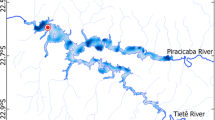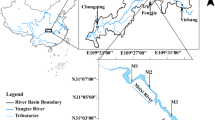Abstract
The thermal regime in large reservoirs plays a significant role in the water quality and ecosystem succession; however, little is known about the impacts of regional climate changes and hydrological conditions on a sizeable stratified reservoir with strong inflow conditions, i.e., the Xiangjiaba Reservoir. Using measured data from 2014 to 2018, the monthly and seasonal variations of the water temperature, thermal stability, and their influencing factors were addressed by using empirical models. The results showed substantial variability and seasonality in the reservoir water temperature, which correlated highly with the air temperature, inflow water temperature, and discharge. Correspondingly, there was a seasonal varying thermal stratification in the reservoir’s yearly cycle, with its duration being up to 4 ~ 5 months, the maximum surface-bottom water temperature difference being up to 7 ~ 10 °C. There were significant positive correlations between Schmidt’s stability index of the thermal structure and inflow-reservoir temperature difference and the surface-bottom temperature differences, while negative correlations with large discharge. Moreover, the inflow tends to influence thermal stability by retaining hypolimnion cold water, with its maximum bottom hysteresis residence time being up to ~ 4 months. Research findings indicated that climate warming in the recent 30 years (1988 ~ 2017) would cause a 0.213 °C/decade and 0.153 kJ/m2/decade increase in reservoir surface water temperature and Schmidt’s stability index, respectively. Among these variations, the inflow temperature increase caused by climate change accounted for the largest proportion, i.e., 0.16 °C/decade and 0.115 kJ/m2/decade. Therefore, climate warming significantly affected the thermal regimes in this large reservoir, and the inflow water temperature increase due to warm air was the main factor altering the reservoir’s thermal structure. Findings from the present study provide a fresh perspective on how to best optimize the deep channel-type reservoirs’ water quality in the face of anticipated climate change.









Similar content being viewed by others
Data availability
The hydrological and meteorological data can be obtained through http://www.ctgpc.com.cn/sxjt/sqqk/ and http://www.cma.gov.cn/, respectively. Other datasets used to support the findings of this study are available from the corresponding author upon request.
References
Adrian, R., Reilly, C. M. O., Zagarese, H., Baines, S. B., Hessen, D. O., Keller, W., & Van Donk, E. (2009). Lakes as sentinels of climate change. Limnology Oceanography, 54(6), 2283–2297.
Becker, V., Caputo, L., Ordóñez, J., Marcé, R., Armengol, J., Crossetti, L. O., & Huszar, V. L. (2010). Driving factors of the phytoplankton functional groups in a deep Mediterranean reservoir. Water Research, 44(11), 3345–3354.
Bouffard, D., & Wüest, A. (2019). Convection in lakes. Annual Review of Fluid Mechanics, 51(1), 189–215. https://doi.org/10.1146/annurev-fluid-010518-040506
Cantin, A., Beisner, B. E., Gunn, J. M., Prairie, Y. T., & Winter, J. G. (2011). Effects of thermocline deepening on lake plankton communities. Canadian Journal of Fisheries Aquatic Sciences, 68(2), 260–276.
Chen, G., Fang, X., & Devkota, J. (2016). Understanding flow dynamics and density currents in a river-reservoir system under upstream reservoir releases. Hydrological Sciences Journal, 61(13), 2411–2426. https://doi.org/10.1080/02626667.2015.1112902
Chen, X., He, D., Zhou, L., Cao, Y., & Li, Z. (2020). Influence of hydropower stations on the water microbiota in the downstream of Jinsha River, China. PeerJ, 8, e9500. https://doi.org/10.7717/peerj.9500
Chen, X., Wang, X., Wu, D., He, S., Kong, H., & Kawabata, Z. (2009). Seasonal variation of mixing depth and its influence on phytoplankton dynamics in the Zeya reservoir. China. Limnology, 10(3), 159–165.
Cheng, F., Li, W., Castello, L., Murphy, B. R., & Xie, S. (2015). Potential effects of dam cascade on fish: lessons from the Yangtze River. Reviews in Fish Biology Fisheries.
Cheng. Y., Voisin. N., Yearsley. J. R., & Nijssen. B. (2020). Reservoirs modify river thermal regime sensitivity to climate change: A case study in the southeastern United States. Water Resources Research, 56(6), e2019WR025784.
Cudaback, C. N., & McPhee-Shaw, E. (2009). Diurnal-period internal waves near point conception, California. Estuarine, Coastal and Shelf Science, 83(3), 349–359. https://doi.org/10.1016/j.ecss.2008.12.018
Curtarelli, M., Alcântara, E., Rennó, C., & Stech, J. (2013). Effects of cold fronts on MODIS-derived sensible and latent heat fluxes in Itumbiara reservoir (Central Brazil). Advances in Space Research, 52(9), 1668–1677.
Duan, W., Guo, S., Wang, J., & Liu, D. (2016). Impact of cascaded reservoirs group on flow regime in the middle and lower reaches of the Yangtze River. Water, 8(6), 218–218.
Duka, M. A., Shintani, T., & Yokoyama, K. (2020). Thermal stratification responses of a monomictic reservoir under different seasons and operation schemes. Science of the Total Environment. https://doi.org/10.1016/j.scitotenv.2020.144423
Gozdowski, D., Žukovskis, J., Razinkovas-Baziukas, A., et al. (2022). Land Cover Changes in Selected Areas Next to Lagoons Located on the Southern Coast of the Baltic Sea, 1984–2021. Sustainability, 14(4), 2006.
Gray, E., Mackay, E. B., Elliott, J. A., et al. (2020). Wide-spread inconsistency in estimation of lake mixed depth impacts interpretation of limnological processes. Water Research, 168, 115136.
Hampton, S. E., Izmest’eva, L. R., Moore, M. V., Katz, S. L., Dennis, B., & Silow, E. A. (2008). Sixty years of environmental change in the world’s largest freshwater lake–Lake Baikal. Siberia. Global Change Biology, 14(8), 1947–1958.
He, T., Deng, Y., Tuo, Y., Yang, Y., & Liang, N. (2020). Impact of the dam construction on the downstream thermal conditions of the Yangtze River. Int J Environ Res Public Health, 17(8). https://doi.org/10.3390/ijerph17082973
Idso, S. B. (1973). On the concept of lake stability. Limnology Oceanography, 18(4), 681–683.
Imberger, J. (1985). The Diurnal Mixed Layer Limnology Oceanography, 30(4), 737–770.
IPCC. (2021). Climate Change 2021, The Physical Science Basis. https://www.ipcc.ch/report/ar6/wg1/
Kuang, L., Zhang, P., Yang, H. Y., Liang, R. F., Wang, Y. M., & Ke-Feng, L. I. (2019). Study on the reducing effect that stoplog gate has played in cascade reservoirs for water temperature stratification. Resources Environment in the Yangtze Basin.
Lenters, J. D. (2004). Trends in the lake superior water budget since 1948: A weakening seasonal cycle. Journal of Great Lakes Research, 30(S1), 20–40.
Levin, K., Waskow, D., & Gerholdt, R. (2021). 5 big findings from the IPCC’s 2021 Climate Report.
Lewis, W. M., McCutchan, J. H., & Roberson, J. (2019). Effects of climatic change on temperature and thermal structure of a mountain reservoir. Water Resources Research, 55(3), 1988–1999. https://doi.org/10.1029/2018wr023555
Li, J., Liang, R., Deng, Y., & Tuo, Y. (2014). Flow field of thermally stratified reservoir. Tianjin Daxue Xuebao /journal of Tianjin University Science Technology, 47(5), 395–400.
Liu, M., Zhang, Y., Shi, K., Zhang, Y., Zhou, Y., Zhu, M., & Liu, M. (2020). Effects of rainfall on thermal stratification and dissolved oxygen in a deep drinking water reservoir. Hydrological Processes, 34(15), 3387–3399. https://doi.org/10.1002/hyp.13826
Livingstone, D. M. (2003). Impact of secular climate change on the thermal structure of a large temperate central European lake. Climate Change, 57(1–2), 205–225.
Ma, Q., Li, R., Feng, J., Lu, J., & Zhou, Q. (2018). Cumulative effects of cascade hydropower stations on total dissolved gas supersaturation. Environmental Science Pollution Research.
Martin, J. L., McCutcheon, S. C., & Schottman, R. W. (1999). Hydrodynamics and transport for water quality modeling: CRC press.
Morovati, K., Tian, F., Kummu, M., Shi, L., Tudaji, M., Nakhaei, P., & Olivares, M. A. (2022). Contributions from climate variation and human activities to flow regime change of Tonle Sap lake from 2001 to 2020. Journal of Hydrology, 2022, 128800.
Mortimer, C. H. (1974). Lake hydrodynamics: With 29 figures in the text. Internationale Vereinigung Für Theoretische Und Angewandte Limnologie: Mitteilungen, 20(1), 124–197.
Mostafa, M. M. H., Liu, C., Wang, S., Wang, L., Liu, X., Zhou, H., & Manickam, S. (2021). Characteristics and driving factors of thermal stratification evolution in Daheiting Reservoir. E3S Web of Conferences, 261. https://doi.org/10.1051/e3sconf/202126104010
Mullin, C. A., Kirchhoff, C. J., Wang, G., & Vlahos, P. (2020). Future projections of water temperature and thermal stratification in Connecticut reservoirs and possible implications for cyanobacteria. Water Resources Research, 56(11). https://doi.org/10.1029/2020wr027185
Nazariha, M., Danaei, E., Hashemi, S. H., & Izad Doustdar, A. M. (2009). Prediction of thermal stratification in proposed Bakhtyari reservoir with CE-QUAL-W2. World Environmental and Water Resources Congress: Great Rivers., 2009, 1–8.
Noori, R., Tian, F., Ni, G., Bhattarai, R., Hooshyaripor, F., & Klove, B. (2019). ThSSim: A novel tool for simulation of reservoir thermal stratification. Science and Reports, 9(1), 18524. https://doi.org/10.1038/s41598-019-54433-2
O’Reilly, C. M., Sharma, S., Gray, D. K., Hampton, S. E., Read, J. S., Rowley, R. J., & Zhang, G. (2015). Rapid and highly variable warming of lake surface waters around the globe. Geophysical Research Letters, 42(24). https://doi.org/10.1002/2015gl066235
Pilotti, M., Simoncelli, S., & Valerio, G. (2014). A simple approach to the evaluation of the actual water renewal time of natural stratified lakes. Water Resources Research, 50(4), 2830–2849.
Rueda, F., & Schladow, G. (2009). Mixing and stratification in lakes of varying horizontal length scales: Scaling arguments and energy partitioning. Limnology Oceanography.
Saber, A., James, D. E., & Hayes, D. F. (2018). Effects of seasonal fluctuations of surface heat flux and wind stress on mixing and vertical diffusivity of water column in deep lakes. Advances in Water Resources, 119, 150–163. https://doi.org/10.1016/j.advwatres.2018.07.006
Shi, L., Sun J., Lin, B., Liu, Z. H., & Zuo, X. (2022). Hydro‐thermodynamic processes at a large confluence under reservoir regulation. Water Resources Research, e2022WR033315.
Simpson, J. H., Woolway, R. I., Scannell, B., Austin, M. J., Powell, B., & Maberly, S. C. (2021). The annual cycle of energy input, modal excitation and physical plus biogenic turbulent dissipation in a temperate lake. Water Resources Research, 57(6). https://doi.org/10.1029/2020wr029441
Smith, J. B. (2004). synthesis of potential climate change impacts on the US.
Verburg, P., Hecky, R. E., & Kling, H. (2003). Ecological consequences of a century of warming in lake Tanganyika. Science, 301(5632), 505–507.
Wang, S., Qian, X., Han, B. P., Luo, L. C., & Hamilton, D. P. (2012). Effects of local climate and hydrological conditions on the thermal regime of a reservoir at Tropic of Cancer, in southern China. Water Research, 46(8), 2591–2604. https://doi.org/10.1016/j.watres.2012.02.014
Woolway, R. I., & Merchant, C. J. (2017). Amplified surface temperature response of cold, deep lakes to inter-annual air temperature variability. Science and Reports, 7(1), 4130. https://doi.org/10.1038/s41598-017-04058-0
Wüest, A., & Lorke, A. (2003). Small-scale hydrodynamics in lakes. Annual Review of Fluid Mechanics, 35(35), 373–412.
Xie, Q., Liu, Z., Fang, X., Chen, Y., Li, C., & MacIntyre, S. (2017). Understanding the temperature variations and thermal structure of a subtropical deep river-run reservoir before and after impoundment. Water, 9(8), 603. https://doi.org/10.3390/w9080603
Zhang, Y., Wu, Z., Liu, M., He, J., Shi, K., Zhou, Y., & Liu, X. (2015). Dissolved oxygen stratification and response to thermal structure and long-term climate change in a large and deep subtropical reservoir (Lake Qiandaohu, China). Water Research, 75, 249–258. https://doi.org/10.1016/j.watres.2015.02.052
Zhang, Y., Wu, Z., Liu, M., He, J., & Yu, Z. (2014). Thermal structure and response to long-term climatic changes in Lake Qiandaohu, a deep subtropical reservoir in China. Limnology Oceanography, 59(4), 1193–1202.
Acknowledgements
The authors are grateful to the funding institutions for their support.
Funding
This research is supported by the National Key R&D Program of China (2016YFE0133700) and the National Natural Science Foundation of China (51779121), and the State Key Laboratory of Hydroscience and Engineering, Tsinghua University (2020-KY-03).
Author information
Authors and Affiliations
Contributions
Lidi Shi: conceptualization, methodology, validation, data curation, formal analysis, resources, writing—original draft, writing—review and editing, visualization. Khosro Morovati: investigation, methodology, validation, formal analysis, writing—original draft, writing—review and editing. Jian Sun: conceptualization, investigation, resources, data curation, writing—review and editing, supervision, project administration, funding acquisition. Binliang Lin: conceptualization, investigation, resources, data curation, writing—review and editing, supervision, project administration, funding acquisition. Xinyu Zuo: date sources, writing—review and editing.
Corresponding author
Ethics declarations
Competing interests
The authors declare no competing interests.
Additional information
Publisher's Note
Springer Nature remains neutral with regard to jurisdictional claims in published maps and institutional affiliations.
Rights and permissions
Springer Nature or its licensor (e.g. a society or other partner) holds exclusive rights to this article under a publishing agreement with the author(s) or other rightsholder(s); author self-archiving of the accepted manuscript version of this article is solely governed by the terms of such publishing agreement and applicable law.
About this article
Cite this article
Shi, L., Morovati, K., Sun, J. et al. Combined effects of climatic change and hydrological conditions on thermal regimes in a deep channel-type reservoir. Environ Monit Assess 195, 334 (2023). https://doi.org/10.1007/s10661-023-10948-w
Received:
Accepted:
Published:
DOI: https://doi.org/10.1007/s10661-023-10948-w




